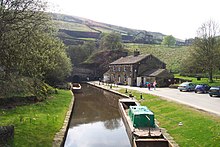 Tunnel End Cottages and the canal portal at Marsden | |
| Overview | |
|---|---|
| Location | Standedge |
| Coordinates | 53°35′12″N 01°57′57″W / 53.58667°N 1.96583°W |
| OS grid reference | SE026105 |
| Status | Open |
| Waterway | Huddersfield Narrow Canal |
| Start | 53°34′04.6″N 01°59′32.7″W / 53.567944°N 1.992417°W |
| End | 53°36′13.5″N 01°56′29.9″W / 53.603750°N 1.941639°W |
| Operation | |
| Constructed | 1794–1811 |
| Opened | 1811 |
| Closed | 1944 |
| Rebuilt | 2001 |
| Owner | Canal & River Trust |
| Technical | |
| Design engineer | Nicholas Brown Thomas Telford |
| Length | 5,675 yards (5,189 m)[1] |
| Towpath | No |
| Boat-passable | Yes (with permission) |
The Standedge Tunnels (/stænɪdʒ/) are four parallel tunnels through the Pennine hills at the Standedge crossing between Marsden in Kirklees, West Yorkshire and Diggle in Oldham, Greater Manchester in northern England. Three are railway tunnels (containing the Huddersfield line) and the other is a canal tunnel. Before boundary changes in 1974, both ends of the tunnels were in the West Riding of Yorkshire.
The canal tunnel on the Huddersfield Narrow Canal was authorised by an Act of Parliament on 4 April 1794. Construction of a 5,451-yard (4,984 m) tunnel began months later.[2] Within two years, cost-saving measures pushed back its completion date and progress was slowed by water levels much greater than had been expected. It proved difficult to secure skilled help, some tenders went unanswered and Benjamin Outram withdrew from the venture. In 1807, Thomas Telford drew up a new plan for its completion. In 1811, the tunnel opened. It is the longest and oldest of the four Standedge tunnels and is the longest, highest, and deepest canal tunnel in the United Kingdom.[3] Having been closed to all traffic in 1943, the canal tunnel was re-opened in May 2001.
The first, single-track railway tunnel, built for the London and North Western Railway (LNWR) on its line between Huddersfield and Manchester, was completed in 1848. It proved to have insufficient capacity and a second, parallel, single-track tunnel was opened in 1871. The LNWR opened a third, double-track tunnel in 1894. Only the double-track tunnel is currently used for rail traffic; the other two are intact but disused.
All four tunnels are linked by cross-tunnels or adits at strategic intervals which allowed the railway tunnels to be built without construction shafts and allowed waste material to be removed by boat. The Standedge Tunnel Visitor Centre, at the Marsden end, is a base for boat trips into the tunnel and has an exhibition depicting the different crossings.
- ^ Ellis 2017, p. 106.
- ^ Ellis 2017, p. 105.
- ^ "Standedge Tunnel and Visitor Centre". Canal & River Trust. Archived from the original on 1 November 2020. Retrieved 28 July 2020.